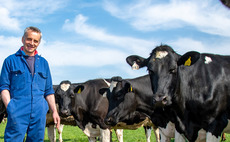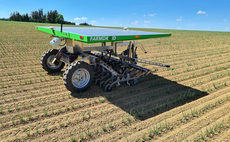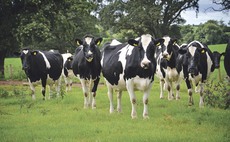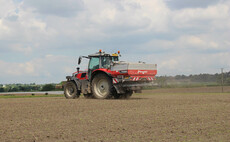One man and his very clever set of IsoBus-controlled triple mowers went to mow a meadow. But how did they perform?
Featuring an all-new suspension system, James Rickard tries out Vicon's latest generation 7 Series mowers...
Apart from the bed, everything about Vicon's latest range of front- and rear-mounted mowers is brand new.
Featuring a whole new frame and race car-inspired suspension design, its new Extra 7100 T ‘butterfly' unit in particular is a world away from the manufacturer's previous machines.
Complementing this is an equally redesigned front mower, the Extra 732 FT.
The new models form part of Vicon's Extra 7 Series mower range, bolstering its current line-up of 600 Series mowers.
In addition, there are fixedarm and variable-arm single rear mowers available in the new series, along with the wider Extra 736 FT front mower, although the latter is unlikely to be offered in the UK due to its transport width.
An auto-swathing ‘BX' version of the rear butterfly unit is also available. Equipped with 10-disc, 3.6m beds, the 7100 T is the widest working width mower Vicon has ever produced.
To find out the capabilities of this new unit and the Extra 732 FT, we pointed our set of test ‘triples' towards some second cut grass and set to.
Providing power was a 250hp Valtra T234 Direct.
CONTOUR FOLLOWING
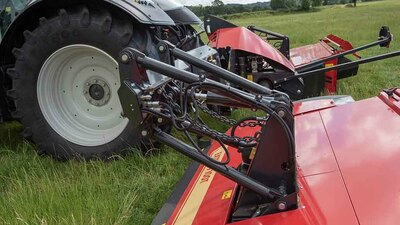
THE highlight of the new mowers is their clever suspension systems, which for the rear mowers is a radical departure from the firm's current construction on the 600 Series machines.
This sees individual hydropneumatic suspension units used for each rear mower.
Connecting the centre of each mowing unit to the mower's new telescoping ‘arms' is an arrangement of parallelogram linkages, dubbed Quattro Link.Within this linkage is also incorporated the accumulators for the suspension and break back safety systems.
Via this, ground pressure can be adjusted from the cab hydraulically.
Suspension travel extends to 450mm of upwards movement, 250mm of downwards travel, and 24-degrees of lateral tilt.
As with the rear mowers, updates to the front mower are equally as substantial, featuring a new style of frame with a stronger tubular construction.
The new frame incorporates a revised suspension unit which offers a greater range of movement, matching that of the rears. As well as offering better floating, it is also more stable. Its geometry also means the bed will pitch up over bumps and pitch down in hollows.
Effective
With several undulations which would test the suspension travel of a Dakar rally truck, our field conditions pushed the mowers' terrain following capability, with both the front and rear units adapting well to the rough, dried out conditions of 2018.
Ground pressure adjustment for the front is via springs. Though it takes a bit more effort to adjust than a hydro-pneumatic system, it is simple and effective.
For stubble height adjustment, the 732 FT gets its own dedicated stubble height control, adjusted via a simple turnbuckle.
Unlike adjusting stubble heights with a top link, this way avoids the impact any adjustment might have on the suspension travel.
Tools for this and suspension adjustment are kept on-board the front mower in a toolbox. We would throw a grease gun in too, as the new frame is fairly laden with grease points, although they only need a shot of grease every two to three days.
ATTACHING AND CONSTRUCTION
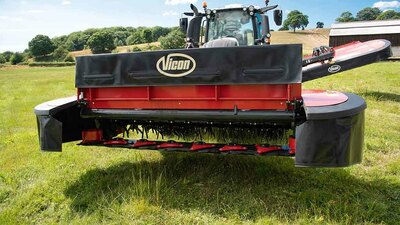
BOTH the front and rear mowers employ sleek, new wedge-shaped styling. Large folding front panels have undoubtedly improved access to the mower beds, which are opened via simple catches.
The same catches are employed on the guards, so no excuse not to use them. And there is the option of hydraulically folding front mower end guards.
End guards are sturdy for the most part, but had a tendency to ‘flap' occasionally when forward speed was pushed.
A-frame
Surrounding all guards is a flexible plastic edge, because we all know that one mower driver who likes to get brave with hedges and fences.
Attachment of the front mower is via an A-frame. However, we would argue large modern tractors have outgrown A-frames, and an option to connect the tractor's front linkage directly to the mower would be welcome.
When unhitching the front mower, a simple sprung-loaded skid which swings into place on the left-hand side provides a sturdy stand. And should you forget to swing it back into its storage position after attaching, it will swing out the way the moment you start mowing.
At the rear, the butterfly's centre section features a fold down stand, which simply swings into place.
The rear unit can also be dropped off and stored with the mowers folded vertically, saving much needed storage space.
SETUP
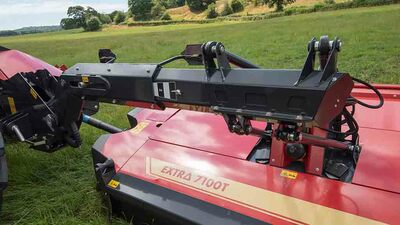
SETUP of both mowers requires the front and rear linkage to be set at a correct height then locked off; raise and lower of the mowers is then down to their own hydraulics.
To set the correct linkage position, this requires a bit of tape measure action, unlike some makes, such as Claas, which incorporate handy markers for a quick setup.
Via telescoping arms, overall rear mower working width can be hydraulically adjusted from 9.8-10.2 metres.
Adjustment is made symmetrically, so no side shifting, but at its narrowest width it affords 400mm of overlap with the front mower, allowing a generous amount of turn before any misses. This is also handy if you need to compensate for any ‘crabbing' on a side slopes.
Constant
Another benefit of telescoping arms to alter width adjustment is that ground pressure levels remain constant no matter what working width, as opposed to pendulum-type working width adjustment systems on some machines, such as Kuhn.
Working width can also be easily seen via markers on the arms, and working width pops up mon screen - useful to know when setting up automatic guidance.
For transport, the press of one button will see the front mower raise, and the rear mowers fold vertically and lock into place. When work is resumed, the rear mowers will remember their previous working width settings.
For extra security, the front mower's suspension frame can be locked solid via a lever located to the left-hand side of the machine.
During transport, a couple of blind spots on the front mower became apparent. Due to the positioning of the fold up guards, it means you cannot see the bed's gearbox stuck out to the left-hand side. If the main top guard ran flush with this it would give you a reference point as to where it is.
CUTTER BAR AND CONDITIONER
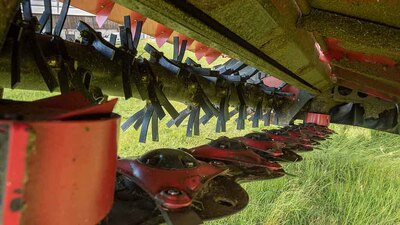
CLAIMED to offer a cleaner cut, as well as better overlap and longer lasting blades, all of Vicon's new mowers stick with its three-bladed design per disc, as opposed to two which all other manufacturers use.
Whether there is any truth in the claimed benefits or not is always up for debate, however, the mowers produced one of the cleanest cuts we have seen, although a lot will be attributed to the suspension design, and the possible dry, brittle nature of 2018's grass.
The bed is the only carry over from previous models, which also sticks with the same semiswing steel conditioner tines.
Quick release blades are available as an option.
All three mowers share the same conditioner plate design which can be conveniently adjusted by levers to alter aggression.
Extensions
Just as easy, swath widths on both the front and rear mowers can be altered via screw-adjustable deflectors.
The deflectors also feature in-built swath board extensions. This is useful on the front mower, as it means grass can be kept in between fat front tyres, avoiding being run on.
In addition, the rear mowers' hoods flip over from a smooth side, which can be used with the swath boards, to a vaned side, which can be used to spread the crop.
It is a smart touch and one which avoids having to get the spanners out to attach vanes. It can also be adjusted in three positions.
Driveline to the front mower's bed is now angled down from the centre gearbox to the bed's 'box, offering more visibility over the top of the mower.
Conditioner is pulley-driven offering two working speeds - 600 or 900rpm. Though less convenient than a gearbox to alter speeds, it is a simple tried and tested design.
Driveline protection on the front mower extends to a slip clutch before the main gearbox, while slip clutches are positioned either side of the main gearbox on the rear unit, protecting each mower unit.
For both front and rear, shear-type disc hub protection is also a feature. However, they do not rise up when sheared like Krone's SafeCut system does, but will certainly give you an audible warning should it shear.
CONTROL AND SERVICE
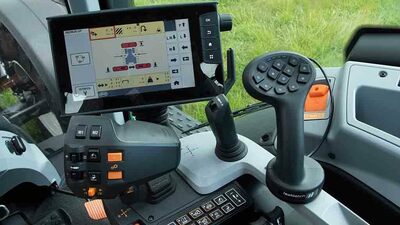
AS an IsoBus-controlled machine only, the rear unit requires either Vicon's own Tellus Go control box, or its higher-spec Tellus Pro, which will also allow the use of Vicon's Geo Mow feature.
The latter works like a sprayer's section control, which sees the mowers automatically raise when driven over an already mown area.
For instance, once the headlands have been mown, the mowers will automatically lift up as soon as they cross over onto the headlands, and vice-versa.
If compatible, you can also plug the mower straight into a tractor's control terminal. And if a tractor has them, you can assign the mowers' various functions to the tractors' own buttons.
In our case, we plugged the mowers straight into the tractor's IsoBus socket, with all mower functions appearing on screen.
From here, the mower's functions could be controlled by tapping the relevant icons on screen.
However, to give some form of physical control, we also plugged in Vicon's own IsoMatch Grip control lever, incorporating assignable buttons. This allows buttons to be configured to how you like them, done via the tractor's screen.
Software
You could argue that this sounds complicated, and underneath the electronics and control software, we are sure it is.
But in terms of hitching up and cracking on, it is very much plug and play. There are no pipes to mix up, no ropes for unlocking catches, just couple up the power beyond hydraulics and plug in the IsoBus socket and go.
To give complete control over the whole rig - for example, the front and rear mowers - the front mower's raise and lower hydraulic service can be plumbed into the rear mowing unit, giving complete and independent control over all three mowers from one controller.
Three modes of operation can be used - manual, headland or GeoMow. We tended to stick with manual, aided by the sheer convenience of the IsoMatch control.
If we were to do larger fields and acreages, headland management could be useful, which can play a sequence at the headland, but because tractor functions such as auto-steer and cruise speeds cannot be integrated into this, you do not gain much more convenience.
Overall operation of the mowers can be as simple or as complex as you make it.
Verdict
Smart design, easy to use and impressive performance make the new series of Vicon mowers stand out. Up there with the top mower makes in the business, the new mowers want for very little, with only a few minor niggles found on our test subjects. If anything, the new mowers could be construed as too clever for some, and a simpler version operated directly by the tractor's spools could be a good option. This said, from an operational point of view, the use of IsoBus and power beyond could not be simpler.

















